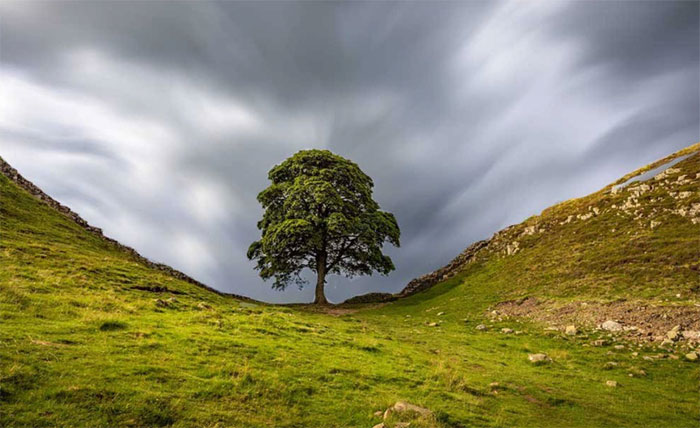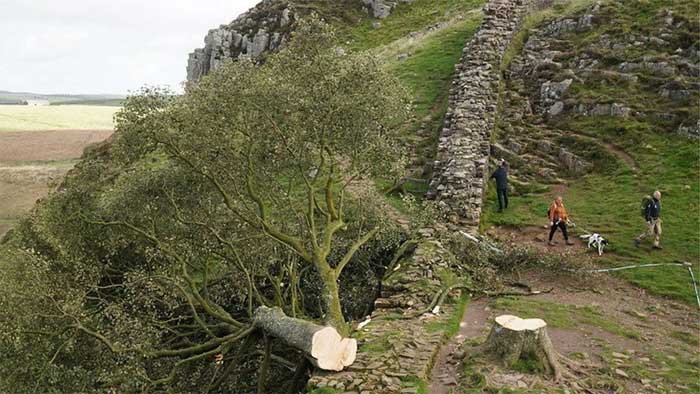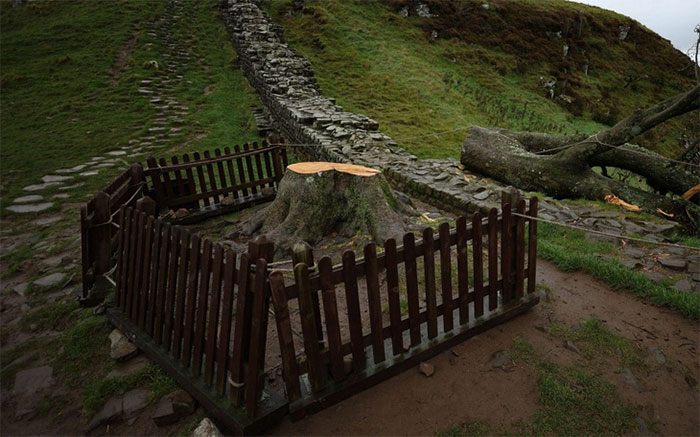'Rebirth' of a 300-year-old sycamore tree that was cut down and left with only bare roots
Half a year after being cut down and leaving only a bare root, a 300-year-old sycamore tree recognized by UNESCO as a heritage has just been "reborn" by scientists.
In September 2023, England was "shocked" when a 16-year-old boy secretly cut down the famous Sycamore Gap sycamore tree in Northumberland National Park.

The UK's most photographed Sycamore Gap tree - (Photo: GETTY IMAGES).
The Sycamore Gap tree is about 300 years old, located next to Hadrian's Wall built by the Romans 1,900 years ago, and is a UNESCO heritage site.
The tree became even more famous when it appeared in the blockbuster "Robin Hood: Prince of the Green Forest" (1991), from which it got the nickname "Robin Hood tree". Major newspapers in the UK consider this the most photographed tree with millions of people visiting and taking pictures every year.
When stolen, the Sycamore Gap tree was left with only bare roots.
As the tree fell, local gardener Rachel Ryver, who was nearby, sprang into action. He climbed over the wall and approached the tree to collect young branches with buds. This is the important "raw material" for splicing genetic copies.


Tree after being cut down and stolen - (Photo: GETTY IMAGES).
Rachel said the air dries very quickly and after the tree dies, the separate parts will soon fail if not treated promptly. A few hours later, Rachel was at Hexham post office to deliver a bag of branches and some seeds to the National Trust Heritage Centre.
Upon receiving the bag, biologist Chris Trimmer examined the contents and cleaned the sample in 5 minutes. Half a day later, Chris had grafted 20 specimens from what was left of the Sycamore Gap tree.
Chris grafted living branches with buds from a Sycamore Gap tree with fresh roots from a tree of the same species. Meanwhile, the seeds are also sown immediately. The seeds are carefully controlled for temperature and humidity to optimize germination.

Young trees are regenerated - (Photo: BBC)
To date, National Trust experts are caring for 9 surviving grafted trees and 40-50 Sycamore Gap seedlings. A bud is about 10cm long.
A BBC reporter recently went to the National Trust to see the Sycamore Gap buds firsthand. At the National Trust, the location of these buds is kept secret to avoid the risk of them being damaged.
In addition, a group of scientists is still waiting at the old tree stump location to see if new shoots can grow. It will take about 3 years to see results.
If the old stump cannot grow new shoots, a Sycamore Gap sapling being nurtured at the National Trust will be planted instead. The remaining seedlings, depending on growing conditions, can be planted in schools or some public locations.
A few varieties will still be kept at the National Trust.
National Trust - A place to preserve super rare trees
The National Trust protects genetic copies of some of Britain's most valuable plants and trees.
There is a replica of the apple tree where Isaac Newton once sat while researching the theory of gravity, and a 2,500-year-old yew tree that witnessed King Henry VIII's love story with the famous Anne Boleyn in the 1530s. .
The National Trust preserves valuable genetic resources, ensuring that British heritage trees will survive, especially through events such as epidemics, devastating storms or attacks.
- Hundreds of years old turned on the original reveal the medieval remains
- Mysterious fir tree regenerates itself from the dead
- The only exotic 'walking tree' in the world
- The 'zombie' tree is fed by the forest
- Japan develops technology to help roots grow three times faster
- Techniques to plant and care for ornamental figs
- The truth about palm trees goes in Ecuador
- The story of ancient oak 'matchmaking' for 100 lovers but is always lonely
- Will the battery be made from tree roots in the future?
- The thousand-year-old Green Lim tree in Yen The is recognized as a Vietnamese Heritage Tree
- 10 species of strange plants in the world
- Resistance against HIV with royal tree roots
 Why do potatoes have eyes?
Why do potatoes have eyes? 'Tragedy' the world's largest carnivorous life: Death becomes ... public toilet
'Tragedy' the world's largest carnivorous life: Death becomes ... public toilet Tomatoes were once considered 'poisonous' for 200 years
Tomatoes were once considered 'poisonous' for 200 years Detecting microscopic parasites on human face
Detecting microscopic parasites on human face